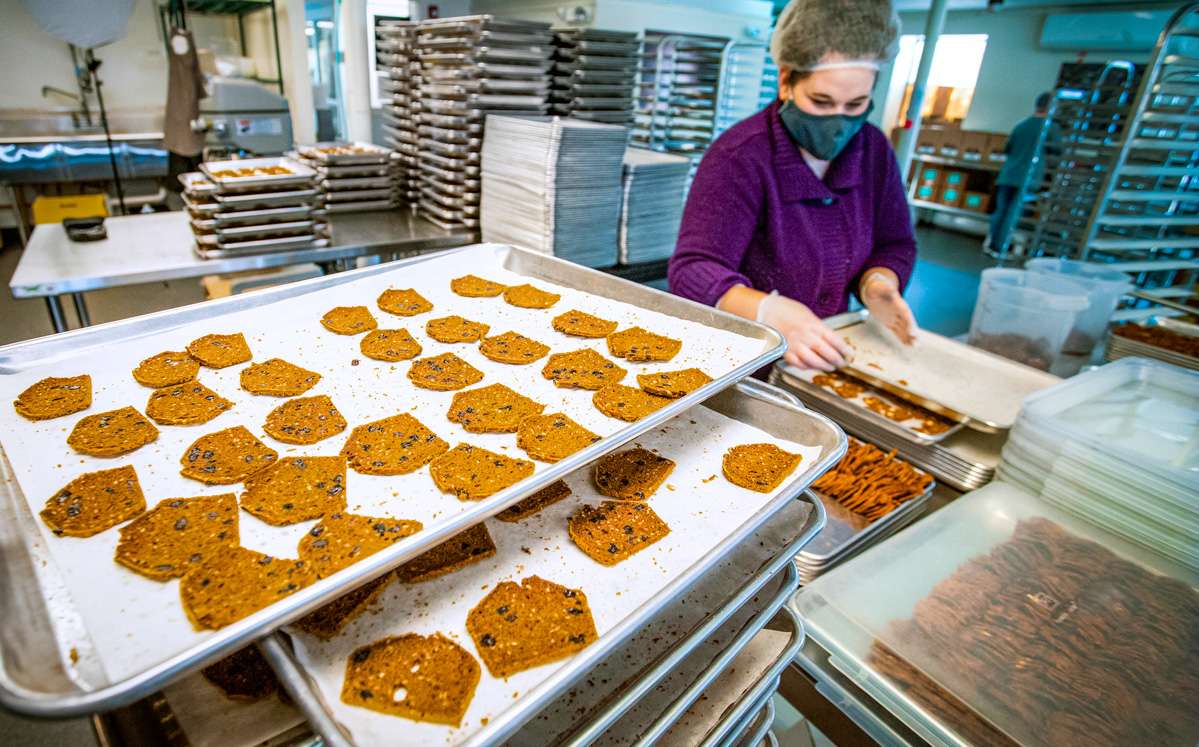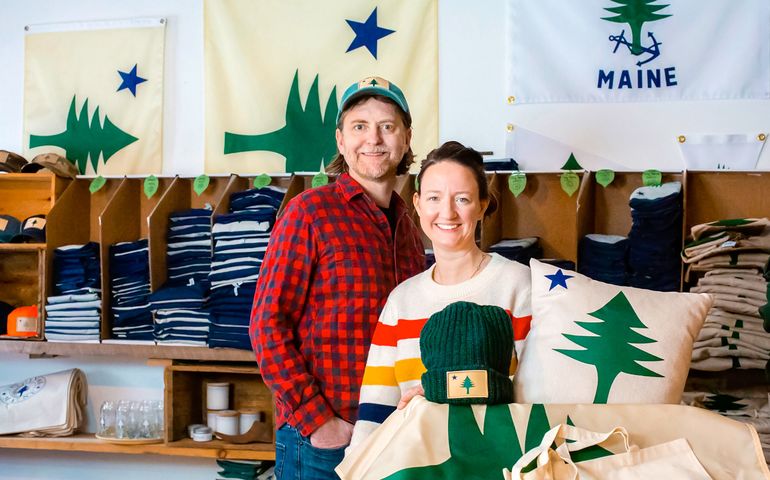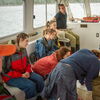
Making in Maine matters: Small manufacturers find success in the state's brand
Chris Korzen, a self-described flag nerd, was looking for a Maine merchant and marine flag as a gift for a friend in 2013. He wanted something high-quality, done in the nautical tradition, with appliques — 13 on each side, it turns out — sewn onto sturdy cloth.
It didn’t exist and he had to have it custom-made by a Connecticut flag-maker.
That sparked an idea for Korzen and his wife, Bethany Field, that evolved into, “Why don’t we purchase some equipment ourselves and learn how to make flags? Maybe people will buy them.”
That was 2013. Eight years later, yes, people are buying them.
Maine Flag Co., owned by Korzen and Field, not only sells nautical flags, but was the developer four years ago of the now-ubiquitous “1901” Maine flag. They started producing it in 2017, and so far, they’ve sold more than 3,800, shipped to 47 states and hand-sewn by Field and four Portland-area contractors. That’s in addition to nautical flags, as well as other products with the 1901 design under their three-year-old Original Maine brand.
They sell both wholesale and COVID-limited retail from their 400-square-foot retail space on Hampshire Street in Portland.
From the start, they decided the business was going to be a Maine company, with all the work done in-state, though they get textiles and some of the apparel that they use for their products out of state.
When they started, both of them still had full-time jobs, Korzen in software development, Field in marketing. It became Field’s full-time job two years ago, when their daughter, Molly, was born.
The success with nautical flags led them to try out the simple pine tree and north star flag that had been Maine’s state flag from 1901 to 1909. Bolstered by some initial interest, Field took out a $5 ad on Facebook in late 2017 to see if they could generate some holiday sales.
“We sold 35 flags in five days,” she says. Then a newspaper story in February 2018 generated more than 100 orders in one day.
Back then, the design wasn’t ubiquitous. “We didn’t know if people would even understand what this was, or why they should buy it,” Korzen says. After the newspaper article, “We realized we’d hit on something.”
They launched the Original Maine brand in March 2018, aiming to promote the design and develop other products with it. That’s now their biggest growth area. They open-sourced the design and now several other companies are making the flag, too.
Korzen says they don’t have an issue with the competition. “Maine’s in need of a symbol it can take beyond its borders.”
The Maine Legislature is considering a bill to make the design the state flag. Whether that’s successful or not, Korzen says the design is here to stay.
The most important thing in flag design is “that people love it and they identify with it and they want to fly it,” he says. “We see the proof in our numbers, we see the proof in the number of other companies that have run with this. People are voting with their wallets.”
At this time last year Maine Flag Co. was looking to bump up their wholesale accounts and Fields was gearing up for the New England Made Trade Show, scheduled for March 14-16.
They already had a strong online platform, so they focused on that, closing their retail store except for curbside. They doubled business over the last year, with growth in both retail and wholesale. Field says that she wonders, without the pandemic, if it would have been more.
They’ve never taken out a loan for the business, reinvesting as they’re able. Now they’ve outgrown their space, and are deciding how to expand to get everything under one roof.
That process, too, is quintessential Maine. “We’re approaching it the way we’ve approached the rest,” Field says. “Figuring out what feels right and not necessarily doing anything that feels too big or too risky.”
They’re also thinking of ways to expand design-wise. “We’re looking back into Maine’s history and finding other tidbits that are representative of who we are as a state,” Korzen says.
Tourists, particularly in 2020, have been a big market, which was a surprise, Korzen says. “People who come here and are shopping in the Old Port. They’re taking this home with them.”
They’re not surprised that something that says “Maine,” not in words but in design, is so popular.
“The values the flag represents — community hard work, self-reliance, nature — that all accounts for a lot of the mystique of Maine and the reason people want to take that image back with them.”
Maine-grown success
Four years ago, Maine Crisp Co. was taking over Karen and Steve Getz’s Waterville house, so they moved it into 2,500 square feet at 10 Railroad Square. Since then, it’s spread into some unused space down the hall and a 3,500-square-foot warehouse in Benton.
Three years after moving out of the house, Maine Crisp is preparing to move into a 17,500-square-foot building in nearby Winslow that CEO Michael Ross bought in December and will lease to the company.
Steve Getz says the move will allow the company to triple its workforce of 11, with more expansion to come.

That’s a fast trajectory for a company that started with award-winning cheesemaker Karen wondering what she could make using Maine buckwheat and blueberries.
It’s the buckwheat that started it. The family, including daughters Rachel and Claire, lived on a farm in Vermont, with Steve working for milk distributor Organic Valley. He frequently made trips to Aroostook County.
He wanted to move to Maine, but Karen wasn’t sold. But she accompanied Steve on one of his visits and saw the waving buckwheat fields in the St. John River Valley, and she was hooked.
Once here, she wanted to do something with the buckwheat, combining it with Maine wild blueberries. “I just didn’t know what,” she says.
After a lot of experimentation, she perfected the gluten-free crisps. The company started small, with food co-ops and natural food stores.
They caught on fast, though. Karen secured financing from CEI and Slow Money Maine, and moved to Railroad Square in 2017.
“I could finally hire someone to help,” she says with a laugh.
Her cranberry-almond crisps won a Sofi award from the Specialty Foods Association in 2018. Ross joined the company that September as CEO and investor. He’d owned a snack distribution business, and also had worked with Steve before, and they worked on building capital.
The past year has been a breakout, including a New England-wide distribution deal with Whole Foods and placement in 17 Hannaford supermarkets in Maine, and 14 in New Hampshire.
The crisps are also sold in specialty stores and used in restaurants, not only in Maine, but nationwide.
As Steve and Karen Getz talked to Mainebiz on a February morning, they stood next to a stack of boxes destined for Eataly, a high-end Italian food marketplace with stores in New York City, Dallas, Los Angeles, Chicago, Toronto, Boston and Las Vegas.
They plan to move this spring or early summer, once the new building is fitted out with things like a large roll-in convection oven to replace the five small temperamental ones they have now, as well as FDA-required space for gluten-free products.

The idea all along, Karen says, was to make a product out of Maine ingredients, starting with the Aroostook County barley that they still use.
Their Maine brand was a factor in both the Whole Foods distribution as well as Hannaford — both companies have a focus on featuring local products.
When they started growing, they wanted to do it in Maine.
“People have an affinity for Maine,” Steve says. But it’s about more than that. “We wanted to showcase it could be done here successfully.”
‘Home-Maine’ ice cream
Gifford’s Famous Ice Cream factory is still at the Skowhegan dairy where Randall and Audrey Gifford began making the ice cream in the 1970s.
The company opened its first ice cream stand in Skowhegan in 1980, and its second one in Farmington in 1982. Stands in Waterville, Bangor and Auburn followed. It’s always been a company with roots firmly in Maine.
Now Gifford’s wants to make sure people know that.
The company is launching a major rebrand with the words “Home-Maine,” a play on “home-made” on its cartons, which have a new packaging design, evocative of rolling Maine landscape, by Portland artist Liza Kelley Sperry.
It turns out, people, even some in Maine, don’t know Gifford’s is a Maine company, says CEO Lindsay Skilling. The company is looking to change that.
“Everything we do, and everything we love is because of Maine,” she says. “Maine and New England.” Nathaniel Main started a dairy business in Connecticut in the 1800s, the first generation in the business. His granddaughter, Audrey, married Randall Gifford in 1947, and they continued the family tradition in Skowhegan.
Skilling says the new look “embodies who we came from.”
“We’re simply made here in Maine,” and it’s important for people to know that, she says.
The company employs 47 year-round and 120 when its ice cream stands are open — which happens later this month.
The company in 2019 underwent a big distribution push, and is in stores down the Atlantic seaboard and as far west as Nevada.
Skilling says that even across the country, the Maine brand resonates. “People think of maybe a simpler time, peace of mind,” she says. “It seems like Maine always carries some weight.”

The tags say ‘Made in Maine’
Maine Stitching Specialties started when Bill and Julie Swain were making Dog Not Gone outdoor visibility products, using space in the Dirigo Stitching factory on Dane Avenue in Skowhegan. When Dirigo owner Peter Shultz retired in 2014, he offered to sell the Swains the company.
“He said, ‘Why don’t you guys buy me out and keep manufacturing here,” Bill Swain says. They changed the name to Maine Stitching Specialties and it was off to the races.
The company, which employs 11, still makes Dog Not Gone products. The company makes tick-resistant dog and people outdoors wear, but also makes the hotel draperies, hospital cubicle drapes it did as Dirigo, as well as American flags, the 1901 Maine flag, and anything else a customer may want if they can make it.
One customer wanted wedge-shaped covers for a foam pillow used to help with nighttime reflux issues. “I went in with a little skepticism,” Swain says. “But before you know it, he was selling hundreds at a time.”
That kind of flexibility is needed in a small shop like Maine Stitching, particularly in the past year, as the hotel drape business slowed to nearly a halt. Drapes need to be replaced as they become worn through multiple washings, and with little hotel business, that wasn’t happening.
“If you have a hole in one business, it needs to get filled,” Swain says.
That hole may be filled by the hospital cubicle curtain side, though hospitals are waiting to see how their revenues are going to shape up after the unexpected year, where revenue-producing elective surgeries also came to a halt.
The company’s American flags, on the other hand, have sold really well in the past year. The company hand-stitches the flags, buying the blue field with stars from an embroiderer.
“We make them one stripe at a time,” he says.
Their biggest customer is Renys, which sells them in its 17 stores across Maine.
Swain says they not only sell them to a lot of Mainers, but to people out of state as well. “People like that they’re made in Maine,” he says.
The Maine brand has a lot of value, he adds. Customers see it as a sign of quality.
“Everything we make that we’re not making for someone else has a tag that says ‘Manufactured in Maine.’”












0 Comments